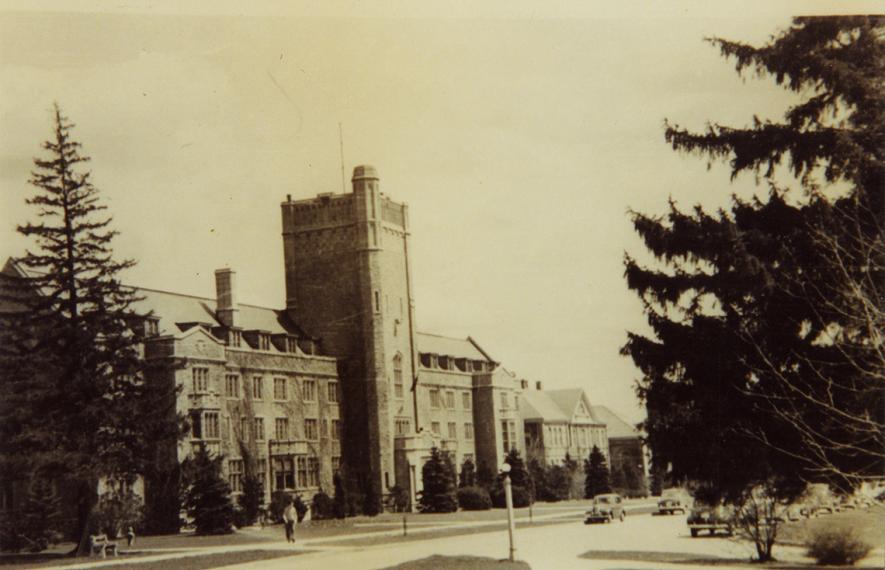Back in the day… memories from an OAC '51

The OAC Class of 1951 celebrated its 70th anniversary in 2021. OAC ’51s have always had a close bond and reputation that other classes have aspired for. To honour this impressive milestone, we spoke with OAC alumnus Dr. Clay Switzer, to learn more about his student experience from 1947 to 1951. Clay is a well-known alumnus and former OAC dean and faculty member.
Choosing OAC
Clay grew up on a farm near London, Ont. In Grade 13, he applied to Western University and the Ontario Agricultural College, which would become one of the founding colleges of the University of Guelph in 1964.
He was partial to OAC because he had visited a few times with his 4-H potato club. Unlike many other students, he wasn’t interested in returning to the farm and wanted to pursue biochemistry. With the help of a “huge scholarship” of $50 a semester, Clay happily chose OAC.
Residence
Many students lived on campus during their entire undergrad. Clay spent most of his years in the former admin building, now known as Johnston Hall. During his first semester, he lived on the third floor and shared a room with three students for $9 a week, including meals at Creelman Hall. The four drew straws for their bunk beds.

“We had to share two desks between the four of us, so the room was pretty much just a place to sleep. What studying we did do at the time was done at the Massey Library.”
During his third year, Clay lived in Watson Hall, where weekends were spent playing bridge, poker and canasta in the common room. His winnings later helped pay for a honeymoon.
“The card games often were continuous over the whole weekend—night and day—with players coming and going.”
Food
“It was good, solid institutional food. For those of us who grew up on farms, eating off tin trays was quite a shock, because we were only used to our mother’s cooking.”
A dress code at Creelman Hall required students to wear a jacket and tie for dinner. Much of the food on the all-you-could-eat menu came from OAC farms. Milk, eggs, cheese, ice cream, fish, lamb and “mystery meat” were common items.
“There was no restriction for what you could take back to your room. It was understood that when you left the dining hall, you’d take some bread and a pitcher of milk. Freshman students were always a little hungry at night. When you walked the halls at night, you’d have the smell of cooking toast.”
Class

Before computers and the internet, students relied on notetaking and books to do well in their classes.
“We had to take good notes during class. We couldn’t just go back and look everything up on Wikipedia. If we didn’t learn something from the professor, we had to pick up a book and read about it. I don’t remember too many of my classmates doing well if they skipped class.”
Choosing a major
Students took seven courses a semester for their common first and second years. During second year, students had to choose their major, which required a signature from a department head.
Clay visited three departments while considering his major. After quick conversations in chemistry and horticulture, he spoke with John D. MacLachlan, head of botany and later the first president of U of G. After an engaging, hour-long conversation, Clay decided to major in botany and plant physiology, which aligned well with his biochemistry interests.
“That visit with Dr. MacLachlan was a great lesson, as it taught me how important it was to take the time to talk with students. J.D. MacLachlan was one of my mentors; he helped define my whole career.”
Extracurriculars

“There is a place called Macdonald Hall, and the girl I took out, Dorothy Allan, was part of the first degree class from Macdonald institute. She and I dated all the way through university, and we married in 1951. So I spent a lot of time as an undergraduate in Mac Hall.”
As a student, Clay played sports, worked a few part-time jobs, took part in class government and spent plenty of time at various social events.
He played for the intercollegiate basketball team, which competed with the junior varsity teams from the University of Toronto, Western and McMaster. The OAC gym floor was slightly smaller than regulation size, which often gave the team a slight advantage during home games. In 1948, OAC won the league title.
Clay also played intramural football, with its rivalry between OAC classes. In the finals of his fourth year, the Class of ’51 lost to the Class of ’53, which they still won’t let him forget.
This article was originally published in the LIBRANNI 2022 / Vol. 4